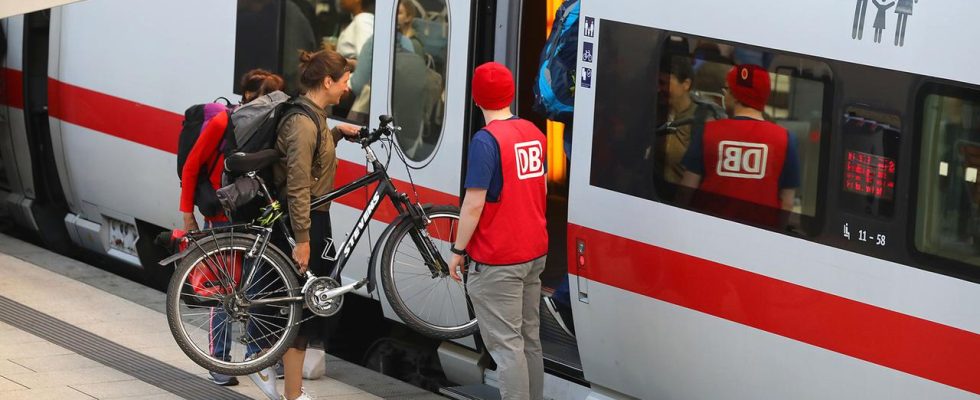According to a Greenpeace test, traveling by train in Europe is often significantly more expensive than flying – environmentalists complain about distorted prices. But there are other obstacles when traveling by train across Europe.
The environmental organization Greenpeace wants to make rail travel within Europe cheaper and therefore more attractive than flying. That’s what it says in a 70-page analysis that compares ticket prices for different modes of transport.
In the analysis “Ticket Prices of Planes vs Trains”, Greenpeace particularly criticizes the climate-damaging effects of the so-called low-cost airlines, whose “unfair and aggressive pricing strategies” are not checked. The organization refers to an extreme example: on the Barcelona-London route, a train ticket costs up to 384 euros, while the testers were able to get hold of a flight for 12.99 euros in the same booking period.
According to the BdL, European air traffic wants to become climate-neutral by 2050
On the occasion of the analysis, Greenpeace travel expert Marissa Reiserer called for a Europe-wide kerosene tax of 50 cents per liter. That would bring in around 46 billion euros in revenue annually, she explained. “More and more people want to travel by train and do without flights, but the lack of a kerosene tax and other climate-damaging subsidies for the airline industry are distorting prices.”
The Federal Association of the German Aviation Industry (BDL) thinks so on request tagesschau.de countered: “Air traffic is not exempt from taxation. However, in 2010 the legislature sensibly introduced an air traffic tax instead of a kerosene tax.”
In the opinion of the BDL, non-uniform taxation of kerosene at international level would have anti-competitive effects. “These would only lead to a shift in CO2 emissions to other regions of the world.” Aviation has also been included in EU emissions trading since 2012 and is aiming to become climate-neutral by 2050.
Mandatory SAFadmixture rate ensures sustainable fuels
In order to achieve this goal, the use of sustainable fuels (Sustainable Aviation Fuel, or SAF for short) in aviation will increase sharply in the coming years. The changeover is likely to be particularly expensive for European airlines. Because within the EU, the aviation industry has agreed on a mandatory SAF admixture quota, which will gradually increase in the coming years.
In addition, the voluntary compensation of the CO2 footprint of a flight by passengers is an instrument on the way to climate-neutral air traffic, said a BDL spokesman tagesschau.de. “Anyone who cannot or does not want to avoid air travel can offset the CO2 emissions of their trip by making a contribution to climate protection projects.”
Deutsche Bahn refers to cheap connections within Germany
Deutsche Bahn also reacted to the Greenpeace study and referred to good domestic German connections, which are often cheaper than the plane. In addition, the DB is “significantly cheaper than the plane when it comes to taking children and luggage with you”. The Greenpeace study does not take this into account. Travelers who take the train can often save themselves the transport from the airport to the city center.
However, the head of transport policy at the Pro-Rail Alliance, Andreas Geißler, criticizes that the expansion of the rail network is lagging behind. In addition, it must be made easier for travelers to book train journeys within Europe. “For cross-border train journeys, travelers often have to laboriously book tickets together with the various national railway companies,” says Geißler tagesschau.de.
In the event of a delay, if the connecting train is missed, the passenger then looks in the tube in some countries. This must also be simplified with a view to climate protection – according to Alianz per rail, traveling by train within Germany is seven times more climate-friendly than flying. According to Greenpeace, the European Environment Agency published a study that calculated that trains in Europe emit five times fewer greenhouse gases per passenger-kilometer on average.
Less than half of railway border crossings electrified
In principle, however, according to Greenpeace traffic expert Reiserer, “not one value can be found.” The emissions are different from one route to another. It depends on the electricity mix, the type of train, the load and the like. “But flying is always more polluting than taking the train, and by a lot,” said Reiserer tagesschau.de.
With regard to the rail connections within Europe, however, the passenger association Allianz pro Schiene still sees a great need for action, also with regard to the rail network. Less than half of the railway border crossings from Germany to other countries are electrified. According to the Pro-Rail Alliance, this means that at the border crossing to the Czech Republic, for example, the ICE locomotive has to be uncoupled and replaced with a diesel locomotive.
This not only makes the rail connections from Germany to other countries slower, but also more cumbersome. “So it shouldn’t come as a surprise that freight traffic is mainly carried out by truck,” said the head of transport policy at the Pro-Rail Alliance tagesschau.de.

